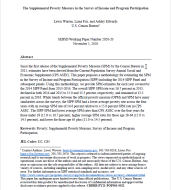
An official website of the United States government
Here’s how you know
Official websites use .gov
A .gov website belongs to an official government organization in the United States.
Secure .gov websites use HTTPS
A lock (
) or https:// means you’ve safely connected to the .gov website. Share sensitive information only on official, secure websites.
-
//
- Census.gov /
- Library /
- Census Working Papers /
- The SPM in the Survey of Income and Program Participation
The Supplemental Poverty Measure in the Survey of Income and Program Participation
The Supplemental Poverty Measure in the Survey of Income and Program Participation
Since the first release of the Supplemental Poverty Measure (SPM) by the Census Bureau in 2011, estimates have been derived from the Current Population Survey Annual Social and Economic Supplement (CPS ASEC). This paper proposes a methodology for estimating the SPM in the Survey of Income and Program Participation (SIPP) including the 2014 SIPP Panel and subsequent panels. Using this methodology, we provide SPM estimates for each year covered by the 2014 SIPP Panel from 2013-2016. The overall SIPP SPM rate was 16.7 percent in 2013, declined in both 2014 and 2015 to 15.0 and 13.3 percent, respectively, and remained at 13.3 percent in 2016. While trends between the official poverty measure (OPM) and SPM have many similarities across the surveys, the SIPP SPM had a lower average poverty rate across the four years with an average SPM rate of 14.6 percent relative to a 15.0 percent SPM rate in CPS ASEC. The SIPP SPM had lower average SPM rates than CPS ASEC over the four years for those under 18 (15.8 vs 16.7 percent), higher average SPM rates for those age 18-64 (15.0 vs 14.5 percent), and lower for those age 65 plus (11.0 vs 14.5 percent).
Share
Related Information
WORKING PAPER
Supplemental Poverty Measure Working PapersSome content on this site is available in several different electronic formats. Some of the files may require a plug-in or additional software to view.
 Yes
Yes
 No
NoComments or suggestions?


Top

